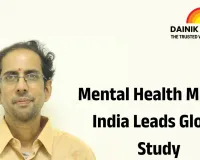India's Battle Against Tuberculosis: A 2025 Deadline Slipping Away
Digital Desk
.jpg)
In the crowded lanes of the Mumbai suburb of Govandi, where families live in cramped, airless spaces, the sound of relentless coughing is a grim daily reality. Here, and in similar pockets across the nation, India is fighting a losing battle against tuberculosis (TB), a deadly disease that experts say has infiltrated almost every second home in some urban compounds .
India is home to a staggering 27% of the world's TB cases and records an average of two deaths every three minutes from the infectious disease, according to the World Health Organization . In 2018, Prime Minister Narendra Modi pledged to eliminate TB in the country by the end of 2025, a goal that global health experts viewed as a "monumental challenge" . With just months until the deadline, that promise is dangerously out of reach .
A Crisis Fueled by Poverty and System Gaps
The struggle is fueled by a "potent combination of biology, poverty and systemic health care gaps" . The bacteria thrives in densely populated, impoverished areas where access to consistent medical care is limited.
· Diagnostic Challenges: A major hurdle is an outdated diagnostic strategy. Nearly three-quarters of diagnoses still depend on sputum microscopy, a method introduced around 140 years ago that can miss active cases. More modern molecular tests are used in just over a quarter of diagnoses .
· Social Stigma: Fear of social isolation prevents many from seeking care or disclosing their status. Health workers report parents hiding a daughter's TB diagnosis, fearing it would ruin her marriage prospects .
· Economic Hardship: For patients like Mehboob Sheikh, who lost his wife to TB a decade ago and is now infected himself, the disease means losing his livelihood. Too weak to work, he struggles to pay his children's school fees .
Innovation in the Face of Adversity
The Indian government has ramped up efforts, offering free testing and medicines and incorporating new technologies into its national strategy . Artificial intelligence is playing a key role, with portable, AI-powered X-ray devices being deployed in slums and remote communities.
"These machines weigh less than 3.5 kilos and can be carried in a backpack," said Dr. Shibu Vijayan of Qure.ai. "They run on batteries, so you can screen an entire community in one day without needing power" . These tools act as a critical triage step, flagging potential cases for confirmatory testing and helping to bridge the diagnostic gap in a country where trained radiologists are scarce .
Despite these "small victories," the 2025 elimination target is unraveling. A 2023 parliamentary report cited major challenges, including staff shortages and poor health-seeking behavior, problems that were exacerbated by the COVID-19 pandemic, which halted screenings and diverted health workers .



1.jpg)
1.jpg)
.jpg)


.jpg)

.jpg)
